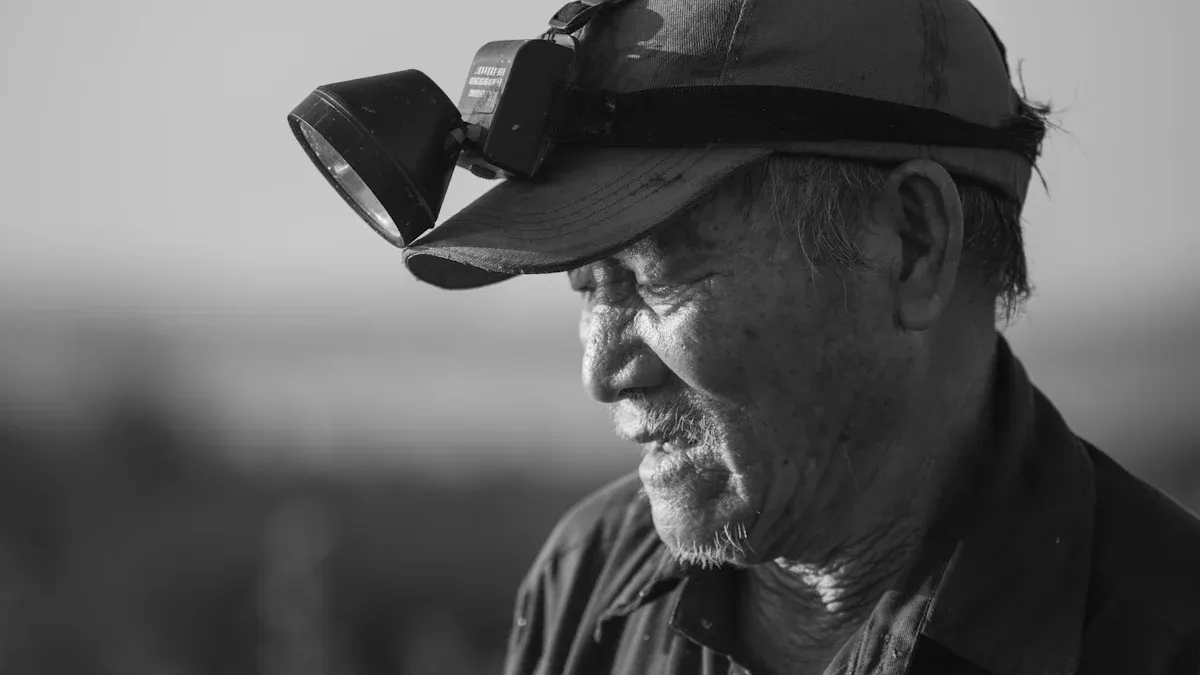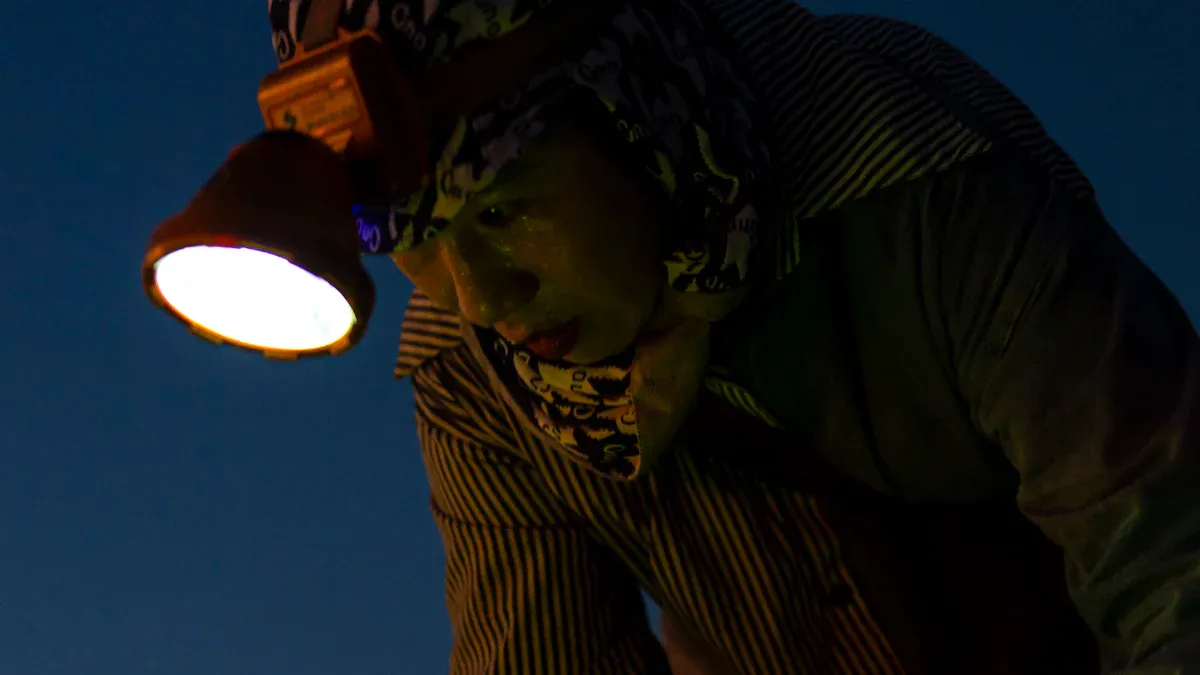Headlamp vs Flashlight Tips for Everyday Use

When you’re deciding between a headlamp and a flashlight, it’s all about how you plan to use it. A headlamp keeps your hands free, making it perfect for tasks like fixing something in the dark or setting up camp. It also offers adjustable brightness and rechargeable options. On the other hand, a flashlight using focused beams is great for precision work or rugged environments. Choosing the right tool ensures you get the best lighting for the job.
Key Takeaways
Headlamps let you use both hands while lighting up. They are great for camping or fixing things.
Flashlights give a strong, focused light. They work well for checking details or in emergencies.
Think about what you need and where you’ll use it. Pick a headlamp or flashlight that fits your task.
Benefits of Using a Headlamp

Hands-Free Lighting for Tasks
A headlamp offers hands-free lighting convenience, making it a game-changer for multitasking. Imagine trying to fix a leaky pipe or assemble furniture in the dark while holding a flashlight. With a headlamp, you can focus on the task without juggling tools and light. It also improves safety by illuminating your path, reducing the risk of tripping or falling. Whether you're navigating a power outage or tackling disaster recovery, a headlamp adapts to your needs effortlessly.
Versatility in Outdoor Activities
When it comes to outdoor adventures, a headlamp is your best friend. It’s perfect for camping, whether you’re setting up a tent or finding your way to the restroom at night. Hikers love it for reading maps and staying on the trail after sunset. If you’re into fishing, a headlamp makes baiting hooks in the early morning a breeze. Even caving or night-time running becomes safer and more enjoyable with the right headlamp lighting your way. Its versatility shines in every outdoor scenario.
Indoor Uses of Headlamp
You might think headlamps are just for outdoor use, but they’re incredibly handy indoors too. Here are some creative uses of headlamp:
Bedtime reading without disturbing others.
Cleaning under beds or in tight spaces.
Repairing toys or electronics.
Sewing or cutting nails with precision.
Sneaking into your child’s room without waking them.
From minor check-ups to romantic dinners, a headlamp proves its worth in countless ways.
Lightweight and Adjustable Design
Comfort matters when you’re wearing a headlamp for extended periods. Adjustable headlamps are designed with lightweight materials, so they don’t feel heavy on your head. Straps are adjustable to ensure a snug fit, and ergonomic designs enhance comfort. Many models offer multiple light modes, allowing you to switch between brightness levels or beam types. With long-lasting battery life and lumens that suit your needs, you’ll find a headlamp that’s both practical and reliable.
Advantages of Flashlights
Focused Lighting for Precision
Flashlights excel when you need precise lighting. Their focused beams make tasks like inspecting engines or identifying wiring in dim spaces much easier. Mechanics often rely on flashlights to see into hard-to-reach areas under vehicles. Electricians use them to pinpoint specific wires in poorly lit conditions. You can even use tactical flashlights to disorient potential intruders, adding an extra layer of security. Advanced features, like the Focus System, help you see details clearly at a distance. Whether you're fixing a leaky pipe or working on a craft project, the right flashlight ensures you have the light exactly where you need it.
Portability and Compact Design
Flashlights are incredibly portable. Their compact size makes them easy to carry in your pocket, bag, or even on a keychain. You can grab one quickly when you're heading out for a nighttime walk or need to check something in the attic. Many models are lightweight yet powerful, offering excellent brightness without taking up much space. This portability makes them a go-to tool for everyday use, whether you're at home or on the move.
Durability for Rugged Use
If you're working in tough environments, a durable flashlight is a must. Many models are built with materials like aluminum or high-grade plastics, making them resistant to wear and tear. Features like waterproofing and impact resistance ensure they perform well in harsh conditions. For example, a flashlight with an IPX7 waterproof rating can handle heavy rain or temporary submersion. Some models even survive drops from two meters onto concrete. These rugged designs make flashlights reliable companions for outdoor adventures or industrial work.
Feature | Description |
|---|---|
IPX7 waterproof rating | Functions in heavy rain or after temporary submersion |
2-meter drop protection | Tested on concrete and steel surfaces |
Sealed construction | Keeps out dust, metal shavings, and worksite debris |
Flashlight Using for Emergencies
A flashlight is essential during emergencies. It provides immediate illumination when the power goes out, helping you navigate safely in the dark. Flashlights also enhance security by lighting up hazards and deterring intruders. They’re invaluable for assessing damage and executing emergency plans. One user even shared how their flashlight saved a life during a crisis, proving its importance in preparedness kits. Whether you're dealing with a natural disaster or a sudden blackout, having a flashlight on hand can make all the difference.
How to Choose Between a Headlamp and a Flashlight
Assess the Task and Environment
The first step in deciding between a headlamp and a flashlight is to think about what you’ll be doing and where. If you need both hands free, like when hiking or setting up camp in the dark, a headlamp is the way to go. Its hands-free operation ensures safety and convenience in tricky situations. On the other hand, flashlights are better for tasks requiring precision, such as inspecting tight spaces or working on detailed projects. Consider the environment too. For outdoor activities, headlamps provide consistent visibility, while flashlights excel in rugged or confined spaces.
Evaluate Brightness and Beam Type
Brightness plays a huge role in your decision. Headlamp brightness levels can match car headlights, making them perfect for lighting up trails or campsites. Flashlights, however, often offer higher brightness for intense illumination. Beam type also matters. Headlamps typically feature floodlight and spotlight modes. Floodlights are great for nearby tasks, while spotlights enhance long-distance visibility. For example, a headlamp beam distance like the Black Diamond Spot 400-R can reach up to 100 meters. Flashlights, with adjustable beams, provide flexibility for various angles and distances.
Consider Comfort and Usability
Comfort is key, especially for extended use. Headlamps with adjustable straps and lightweight designs ensure they stay secure without causing discomfort. Look for models with multiple light modes to suit different tasks. Flashlights, while not worn, should feel comfortable in your hand and be easy to operate. Both tools should be durable enough to handle dark conditions and outdoor challenges.
Tip: Choose headlamps with ergonomic designs and flashlights with textured grips for better usability.
Budget and Longevity Factors
Your budget can influence your choice. Flashlights generally cost less than headlamps with similar brightness. However, affordable headlamp options, like the Coast FL11, are available for around $23. Longevity also matters. A durable flashlight or a headlamp with a long-lasting battery ensures you won’t need frequent replacements. Think about how often you’ll use the tool and invest accordingly.
Comparison: Headlamp vs Flashlight

Key Features and Applications
When comparing headlamps and flashlights, their features and applications stand out. A headlamp offers hands-free operation, making it perfect for tasks like hiking, biking, or working in the dark. Flashlights, on the other hand, provide a focused beam and are easy to maneuver, making them ideal for precision tasks or emergencies.
Here’s a quick breakdown of their key features:
Feature | Headlamps | Flashlights |
|---|---|---|
Durability | Made from durable materials like aluminum | Also made from durable materials |
Waterproof and Impact-Resistant | Yes | Yes |
Adjustable Brightness | Yes | Yes |
Beam Focus | Yes | Yes |
Hands-Free Operation | Yes | No |
Industry-Specific Applications | Ideal for construction and mining | Suitable for various outdoor and emergency uses |
Headlamps shine in industries like construction, mining, and oil and gas, where safety and hands-free lighting are critical. Flashlights excel in outdoor adventures and emergency scenarios, offering portability and precision.
Pros and Cons of Each Option
Both tools have their strengths and weaknesses. Here’s what you should know:
Pros of Headlamps:
Hands-free operation lets you multitask effortlessly.
Perfect for activities like hiking, climbing, or setting up a tent.
Cons of Headlamps:
Less durable than flashlights, especially in rugged conditions.
Limited beam angle adjustability compared to flashlights.
Pros of Flashlights:
Highly durable and built to withstand rough handling.
Offers better control over beam direction and intensity.
Cons of Flashlights:
Requires one hand to operate, which can be inconvenient.
Not as practical for tasks requiring constant movement.
Ultimately, your choice depends on your needs. If you’re navigating a trail in the dark, a headlamp is your best bet. For emergencies or detailed work, a flashlight provides unmatched precision and reliability.
Both headlamps and flashlights offer unique benefits. Headlamps provide hands-free lighting, making tasks safer and more efficient, especially in the dark. Flashlights deliver precision and durability for emergencies. Owning both ensures you're prepared for any situation, whether you're hiking, working on projects, or responding to unexpected challenges. Versatility starts with the right tools.
FAQ
What’s the best headlamp brightness for outdoor activities?
For outdoor activities, aim for 200-400 lumens. This range provides enough light for hiking, camping, or running without draining the battery too quickly.
Tip: Choose a headlamp with adjustable brightness for flexibility.
Can I use a flashlight for hiking?
Yes, you can. Flashlights work well for hiking if you don’t need hands-free lighting. Opt for a lightweight, durable model with a long beam distance.
How do I maintain my headlamp or flashlight?
Keep it clean and dry. Check the batteries regularly. Store it in a cool, dry place to prevent damage. Replace worn-out straps or seals when needed.
Note: Rechargeable models need periodic charging to maintain battery health.
See Also
Selecting the Ideal Headlamp Flashlight for Your Needs
Comparing Police Flashlights and Standard Flashlights: A Guide
Key Guidelines for Proper Flashlight Care and Maintenance
